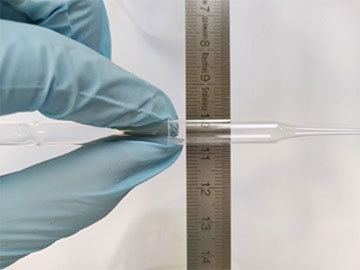
Single-crystal organometallic perovskite optical fiber. [Image: L. Su]
While silica optical fibers are ubiquitous, semiconductor-core fibers can take advantage of electronic, thermoelectric, optoelectronic, optically nonlinear and even mechanical properties not present in glasses. Several types of semiconductor materials have been used to make optical fibers, including silicon, germanium, II–VI compounds and chalcogenides.
For the first time, researchers have created optical fibers with a core consisting of single-crystal organometallic perovskite (Sci. Adv., doi: 10.1126/sciadv.abq8629). Due to the material’s unique properties, such fibers have promising applications for high-speed, all-fiber optoelectronics, where light generation, modulation and detection can all be performed within a fiber.
A novel idea for perovskites
Perovskites have been touted as next-generation materials for devices such as solar panels and LED-based displays, as a result of their large carrier mobilities, tunable band gaps and simple solution preparations. Lei Su of Queen Mary University of London, UK, and his colleagues had been working with single-crystal perovskites for many years when they decided to experiment with a brand-new application for the material.
“At present, most optical fibers are made of glass. The idea suddenly came to us one day: Why don’t we try to grow an optical fiber using single-crystal perovskites?” said Su.
To do so, they faced a considerable challenge in terms of achieving continuous one-directional growth in the axial direction while restricting growth in the radial direction. Multiple crystals can easily form during the process, leading to polycrystalline perovskites, which will not transmit light.
Specialized devices and new applications
The researchers developed a novel temperature growth method that allowed them to grow and precisely control the length and diameter of single-crystal perovskite fibers in liquid solution. Capillary tubes filled with precursor solution are fixed perpendicular to the ground, and a heat-transfer block is placed on a hot plate in contact with the capillary.
“We gradually changed the heating position, line contact and temperature during the process to ensure continuous epitaxial growth in the length while preventing random crystal formation in the width,” said Su. “With our method, the length of the fiber can be controlled, and the cross section of the perovskite fiber core can be varied.”
Su and his colleagues created optical fibers with a core diameter as low as 50 µm. Testing revealed good stability over several months, low transmission losses (less than 0.7 dB/cm) and mechanical flexibility (bending radius as small as 3.5 mm). Using this growth process, they claim these perovskite fibers can, in principle, reach indefinite lengths.
“The fibers could be used to make specialized devices in optical communication networks for lasing, amplification and energy conversion,” he said. “They could also be used in applications such as medical imaging and solar-powered textiles.”
